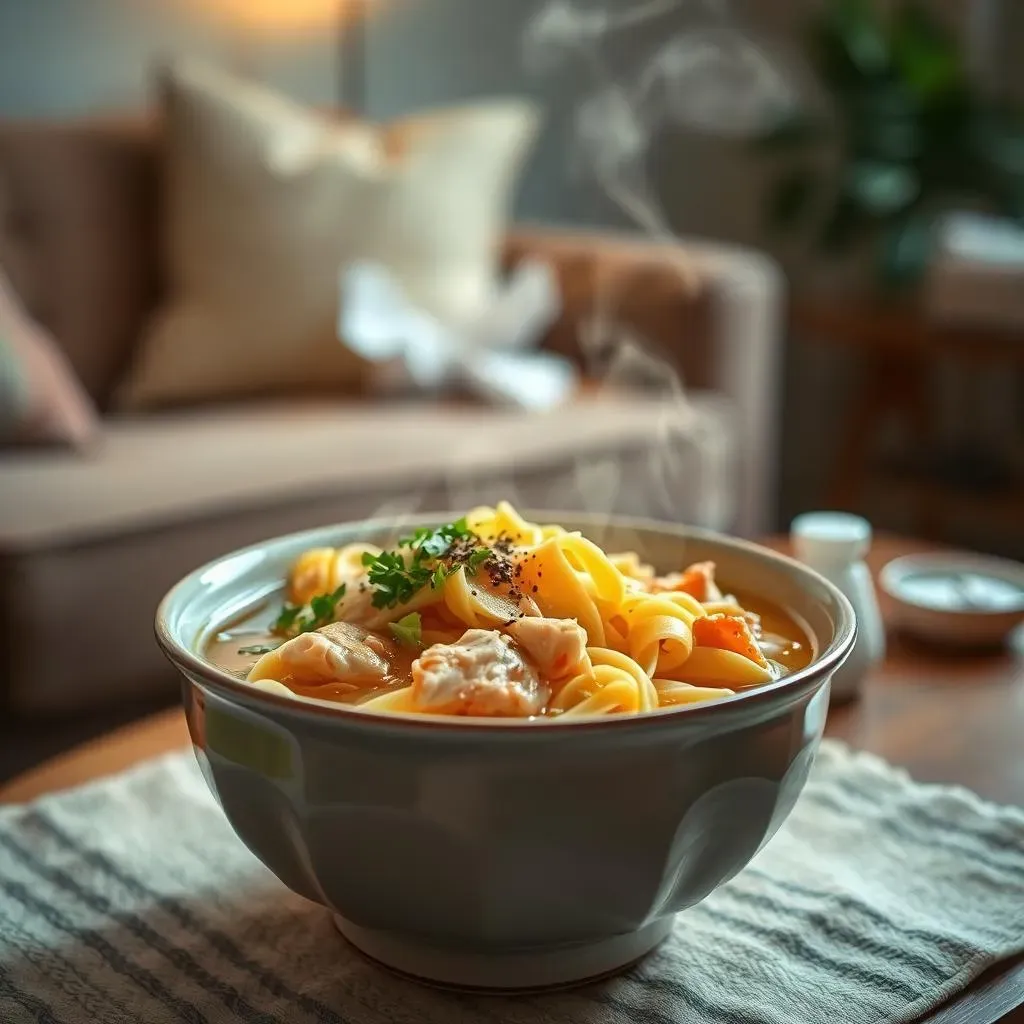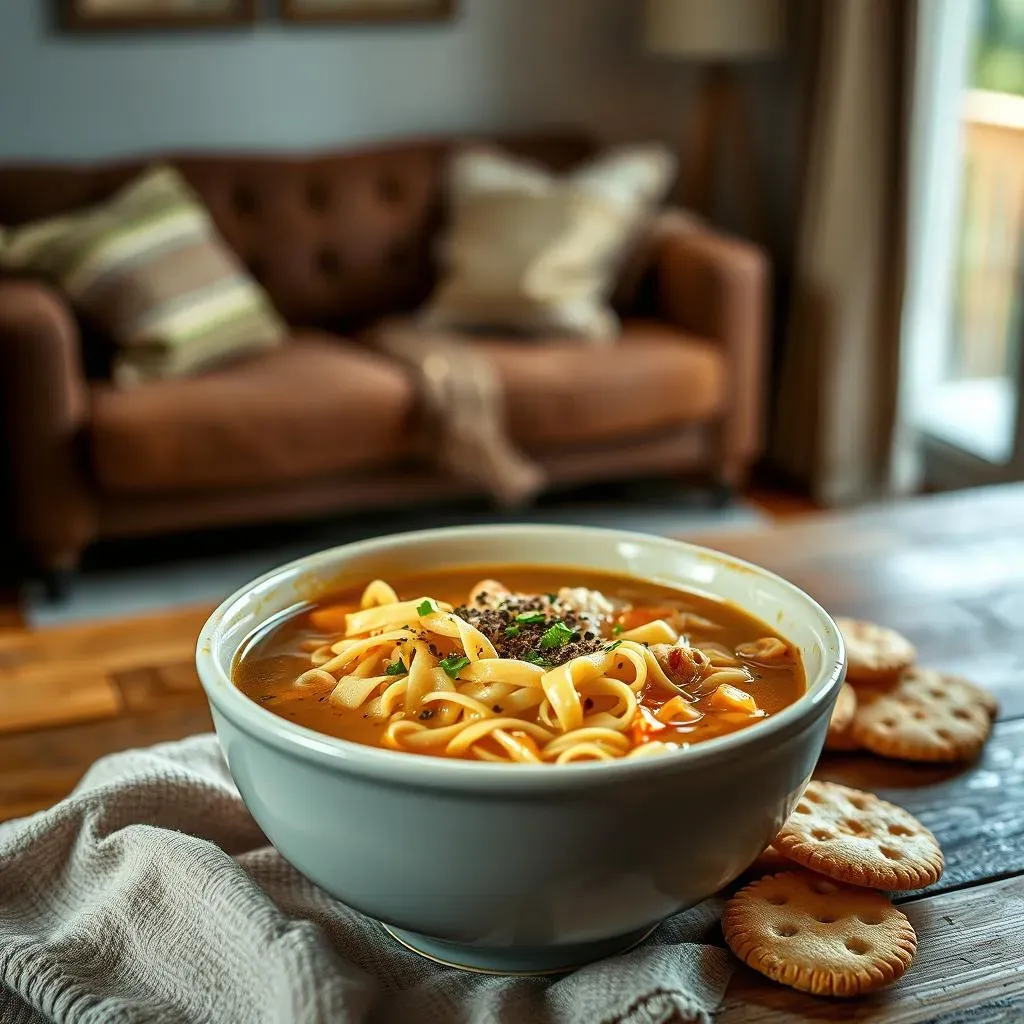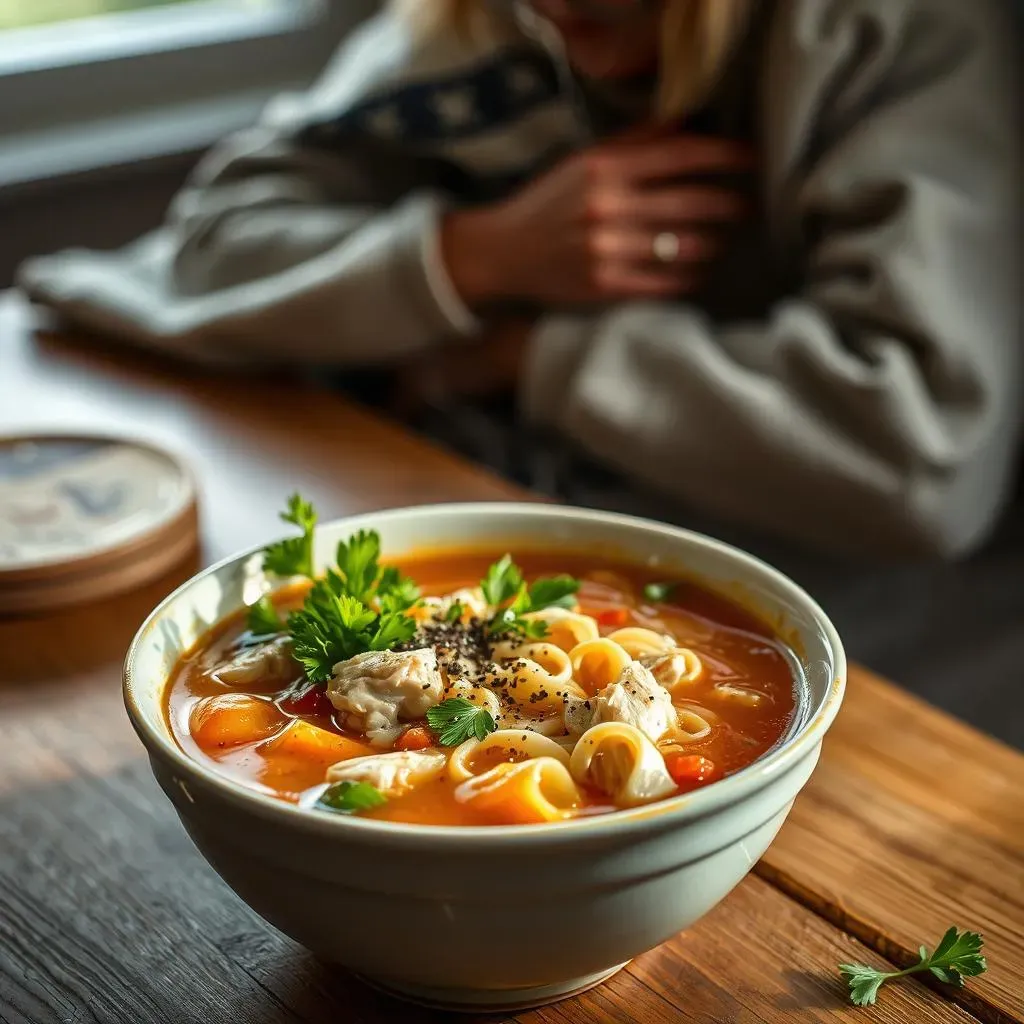Table of Contents
Feeling under the weather? That familiar achy feeling, the sniffles, the overall blahs? You might be reaching for the tissues, but we're here to tell you about a powerful ally in your fight against the flu: chicken noodle soup for flu recovery. This isn't just grandma's old wives' tale; there's actual science behind why this comforting classic can ease your symptoms and help you feel better faster. In this article, we'll explore the science supporting chicken noodle soup's effectiveness, providing you with a delicious and effective recipe. We'll then show you how to supercharge your soup with extra flu-fighting ingredients, turning it into a true medicinal marvel. Finally, we'll tackle your frequently asked questions and offer solutions to common problems, ensuring you can confidently whip up a batch of this healing elixir. Get ready to discover the power of a bowl of warm comfort and effective flu recovery!
The Science Behind Chicken Noodle Soup for Flu Recovery

The Science Behind Chicken Noodle Soup for Flu Recovery
Hydration and Electrolyte Balance
Let's face it: the flu can really dehydrate you. Vomiting and diarrhea, common flu symptoms, lead to significant fluid loss. Chicken noodle soup, being primarily broth-based, helps replenish these fluids. The salt in the broth also helps replace lost electrolytes, which are crucial for maintaining proper bodily functions. Think of it as a gentle, delicious IV drip for your system. This is particularly important for children, who can dehydrate quickly during a bout of the flu.
This replenishment is key to helping your body fight off the infection. Dehydration weakens your immune system, making it harder to combat the virus. By restoring your fluid balance, chicken soup gives your body the resources it needs to recover.
Electrolyte | Importance in Flu Recovery |
|---|---|
Sodium | Regulates fluid balance, nerve and muscle function. |
Potassium | Supports muscle contractions, nerve signals, and fluid balance. |
Chloride | Maintains fluid balance, assists in digestion. |
Soothing Inflammation
Many of the ingredients in chicken noodle soup have anti-inflammatory properties. Chicken broth, rich in amino acids like cysteine, can help thin mucus, making it easier to clear from your respiratory system. The vegetables—carrots, celery, onions—contain antioxidants and vitamins that further support your body's natural healing processes. Think of it as a gentle army of tiny fighters, supporting your immune cells in their battle against the flu.
This anti-inflammatory effect is particularly helpful in reducing congestion and easing sore throats. The warm broth itself also has a soothing effect, comforting irritated tissues and providing a sense of relief. While it's not a magic cure, it provides significant symptomatic relief, making you feel a little bit better.
- Chicken broth: Contains cysteine, which thins mucus.
- Carrots: Rich in beta-carotene, an antioxidant.
- Celery: Contains antioxidants and anti-inflammatory compounds.
- Onions: Contain quercetin, an antioxidant with anti-inflammatory properties.
Immune System Support
While chicken noodle soup won't magically eradicate the flu virus, it does provide nutritional support for your immune system. The chicken itself is a good source of protein, essential for building and repairing tissues. The vegetables contribute vitamins and minerals that are crucial for immune function. It's not a replacement for a balanced diet, but it's a helpful boost when your body is battling an infection. Think of it as giving your immune cells a much-needed energy drink.
Remember, a strong immune system is your best defense against illness. While chicken noodle soup isn't a miracle cure, it contributes to overall well-being by providing essential nutrients and easing symptoms, allowing your body to focus its energy on fighting the infection.
Best Chicken Noodle Soup Recipe for Flu Recovery

Best Chicken Noodle Soup Recipe for Flu Recovery
The Foundation: A Flavorful Broth
Let's start with the heart of the matter – the broth! Forget those bland, watery broths. We're aiming for a rich, flavorful base that will not only hydrate but also tantalize your taste buds. Start with a whole chicken (about 3-4 pounds), ideally organic. This allows for maximum flavor extraction. Simmer the chicken in about 8 cups of water with roughly chopped carrots, celery, and onion (a classic mirepoix) for at least an hour, or until the chicken is falling apart. This slow simmering process extracts the maximum flavor and nutrients from the chicken and vegetables.
Don't be shy with the aromatics! Add a few cloves of garlic, a couple of sprigs of fresh thyme and parsley, and a bay leaf for extra depth. Once the chicken is cooked through, remove it from the pot, let it cool slightly, and then shred the meat, discarding the skin and bones. Strain the broth, reserving the flavorful liquid. This broth is the base of your healing potion, so make it count!
Ingredient | Purpose |
|---|---|
Whole Chicken | Rich flavor and protein |
Mirepoix (Carrots, Celery, Onion) | Sweetness, depth of flavor, and nutrients |
Garlic, Thyme, Parsley, Bay Leaf | Aromatic complexity and immune-boosting properties |
Adding the Goodness: Vegetables and Noodles
Now that we have a fantastic broth, let's add the supporting cast of characters: the vegetables and noodles. You can stick with the classic carrots, celery, and onions, finely diced, or get creative! Consider adding diced sweet potatoes for extra sweetness and vitamin A, or some finely chopped spinach for a boost of iron and other nutrients. Remember, the more vibrant the color of your vegetables, the more antioxidants they contain. The key is to add the vegetables during the last 20 minutes of cooking so they retain their nutrients and remain tender-crisp.
For noodles, egg noodles are a classic choice, but you can experiment with other types, such as small pasta shapes or even rice noodles for a gluten-free option. Add the noodles during the final 10-15 minutes of cooking time, following the package directions. Don't overcook them; you want them to be tender but still have a bit of bite.
- Carrots: Beta-carotene, vitamin A
- Celery: Antioxidants, fiber
- Onions: Quercetin, anti-inflammatory properties
- Sweet Potatoes: Vitamin A, fiber
- Spinach: Iron, vitamins
The Finishing Touches: Seasoning and Serving
Finally, it's time to season your soup. Salt and pepper are essential, of course, but don't be afraid to experiment with other seasonings. A pinch of turmeric adds anti-inflammatory benefits, while a squeeze of lemon juice brightens the flavors and adds vitamin C. If you like a little heat, a dash of red pepper flakes can add a nice kick. Remember, taste as you go and adjust seasonings to your preference. The beauty of this recipe lies in its adaptability; feel free to customize it to suit your tastes and dietary needs.
Once your soup is ready, ladle it into bowls and enjoy! This is the perfect comfort food to soothe a sore throat, ease congestion, and provide your body with the nutrients it needs to recover. Serve with a slice of crusty bread for dipping, if desired. And don't forget the extra TLC – rest, hydration, and plenty of sleep are just as crucial for a speedy recovery!
Boosting Your Chicken Noodle Soup's FluFighting Power

Boosting Your Chicken Noodle Soup's FluFighting Power
Supercharging with Spices
Let's take our already amazing chicken noodle soup and kick it up a notch! Adding certain spices can significantly boost its flu-fighting potential. Think of it as adding extra firepower to your immune system's arsenal. Turmeric, known for its anti-inflammatory properties, is a fantastic addition. Ginger, another potent anti-inflammatory, adds a warming zing. Garlic, a natural antibiotic, adds a pungent punch. A pinch of cayenne pepper can help clear congestion. Don't be afraid to experiment with different spice combinations to find your perfect blend. A little goes a long way, so start with small amounts and adjust to taste.
These spices aren't just for flavor; they pack a nutritional punch. Turmeric contains curcumin, a powerful antioxidant with anti-inflammatory effects. Ginger contains gingerol, which possesses anti-inflammatory and analgesic properties. Garlic contains allicin, which has antibiotic and antiviral properties. Incorporating these powerhouse ingredients transforms your soup from a comforting meal into a true medicinal elixir.
Spice | Benefits |
|---|---|
Turmeric | Anti-inflammatory, antioxidant |
Ginger | Anti-inflammatory, analgesic |
Garlic | Antibiotic, antiviral |
Cayenne Pepper | Decongestant |
Adding Extra Nutritional Powerhouses
Beyond spices, we can further enhance our soup's flu-fighting capabilities by adding other nutrient-rich ingredients. Consider adding a squeeze of fresh lemon juice for its vitamin C content, a known immune booster. A handful of chopped fresh herbs, such as parsley or cilantro, adds extra vitamins and antioxidants. Bone broth, rich in collagen and minerals, can provide additional support for your immune system and gut health. Think of these additions as strategic reinforcements, bolstering your body's defenses against the flu.
These additions aren't just about adding flavor; they're about maximizing the nutritional value of your soup. Vitamin C from lemon juice helps support immune function and acts as an antioxidant. Fresh herbs contribute a variety of vitamins and minerals. Bone broth provides essential amino acids, minerals, and collagen, supporting gut health and immune function. By strategically incorporating these ingredients, you're creating a truly potent and nourishing soup that can aid in your recovery.
- Lemon Juice: Vitamin C, antioxidant
- Fresh Herbs (Parsley, Cilantro): Vitamins, antioxidants
- Bone Broth: Collagen, minerals, gut health support
Chicken Noodle Soup for Flu Recovery: FAQs and Troubleshooting

Chicken Noodle Soup for Flu Recovery: FAQs and Troubleshooting
Can I make chicken noodle soup ahead of time?
Absolutely! Chicken noodle soup is even better the next day, as the flavors meld together. You can make a large batch and store it in the refrigerator for up to 3 days or freeze it for longer storage. Just be sure to let it cool completely before refrigerating or freezing to prevent bacterial growth. When reheating, gently simmer on the stovetop or microwave until heated through.
Freezing individual portions is also a great idea for quick meals during a busy week or when you're feeling under the weather. Simply portion the soup into freezer-safe containers, label them with the date, and freeze. To reheat frozen soup, thaw overnight in the refrigerator and then reheat gently on the stovetop or in the microwave. Avoid rapid temperature changes which can affect the taste and texture of your soup.
Storage Method | Storage Time | Reheating Instructions |
|---|---|---|
Refrigerator | Up to 3 days | Gently simmer on stovetop or microwave |
Freezer | Up to 3 months | Thaw overnight, then reheat gently |
What if I don't have all the ingredients?
Don't worry if you don't have every ingredient listed in the recipe. Chicken noodle soup is incredibly versatile! Feel free to substitute ingredients based on what you have on hand. For example, if you don't have fresh herbs, you can use dried herbs instead (just use a smaller amount). If you don't have bone broth, chicken broth works perfectly fine. If you're missing a particular vegetable, simply omit it or substitute with a similar one. The most important thing is to create a flavorful and comforting soup that will help you feel better.
The beauty of this recipe lies in its adaptability. Use whatever vegetables you have on hand or are in season. Experiment with different noodle types or even add grains like rice or quinoa for extra texture and nutrition. The goal is to create a nourishing and delicious soup that will aid in your recovery. Don't stress about perfection; focus on creating a comforting and flavorful meal that meets your needs.
- Substitute dried herbs for fresh (use less).
- Use chicken broth instead of bone broth.
- Substitute similar vegetables (e.g., zucchini for yellow squash).
- Add grains like rice or quinoa for extra nutrition.
My soup is too bland, what can I do?
If your chicken noodle soup is a bit bland, don't despair! There are several ways to easily boost the flavor. A squeeze of fresh lemon juice can add brightness and acidity. A dash of soy sauce or Worcestershire sauce can add umami depth. A pinch of salt and pepper can always help to enhance the overall flavor profile. Consider adding a few dashes of your favorite hot sauce for a spicy kick. If you have leftover herbs, a sprinkle of fresh chopped parsley or cilantro adds a burst of freshness.
Remember, taste as you go and adjust seasonings to your preference. A little bit of experimentation can make a big difference. Don't be afraid to get creative and find the perfect flavor balance that suits your palate. The most important thing is to create a soup that is both delicious and nourishing.
